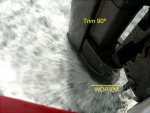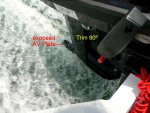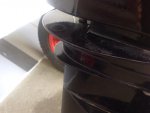Some tech issues to consider :
To take the most out of your particular 365-9.8 HP setup you need 2 issues to consider that works hand in hand, transom height and engine power. To start with, engine must be seated at 90 angle on transom, or perpendicular to water level once sib is floating empty. Adjust trim to achieve that condition.
So you have placed a wooden shim to raise engine as you probably were experiencing water splashes over engine, right ? If so, you need to correct dial the Sweet transom height spot for that Tohatsu engine. You can only have 2 possible heights for water flow to pass by at plane.
Right under small water deflector plate (WDP) and above anti ventilation plate (AVP). Do not have it clear where is your actual water flow is passing by ?
Sit on middle deck next to transom, go for a wot spin you alone on flat calm, no wind water, first hour of day could be best, once on plane, pull your head over next to engine side and check at which height is flow passing by. Check pics (if visible)
First corresponds to WDP, second to AVP. Shim transom +,- to achieve that first condition. If water flow is passing right in middle of both, it is much better than just passing by second, but 1 is top performer. More water bed level for prop to bite & grip better than in 2.
Once you have it correctly dialed, could make a permanent shim installation, and rise both engine plates to be even with newly raised transom border, that way when adjusting engine, both engine clamps will be adjusted around middle plate.
With respect to elevation issues, the power loss is around 20% at each 1K meters (3300 Ft) There are market available high altitude kits in 1K increments, max is around 3K Ft. At only 5K Ft, playing with jets and prop pitch should be able to squeeze the near top HP out of that 9.8. Other story is passing 10 K Ft and higher.
Happy Boating






















